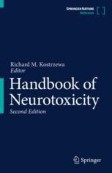Search
Search Results
-
Mitochondrial Complex I Inhibition in Dopaminergic Neurons Causes Altered Protein Profile and Protein Oxidation: Implications for Parkinson’s disease
Mitochondrial dysfunction and oxidative stress are critical to neurodegeneration in Parkinson’s disease (PD). Mitochondrial dysfunction in PD entails...

-
JM-20, a Benzodiazepine-Dihydropyridine Hybrid Molecule, Inhibits the Formation of Alpha-Synuclein-Aggregated Species
Studies showed that JM-20, a benzodiazepine-dihydropyridine hybrid molecule, protects against rotenone and 6-hydroxydopamine neurotoxicity. However,...

-
Molecular Structure, Mode of Action, Immunology, Safety, and Side Effects of BoNTs
This chapter describes the molecular structure of botulinum neurotoxins (BoNT), the functions of light chain and heavy chain, and how after...
-
The History of Botulinum Neurotoxins: From 1820 to 2020
Nearly 200 years ago (1820), a young German physician Justinus Kerner predicted that the agent responsible for “sausage poisoning “could have...
-
Not Goanna Get Me: Mutations in the Savannah Monitor Lizard (Varanus exanthematicus) Nicotinic Acetylcholine Receptor Confer Reduced Susceptibility to Sympatric Cobra Venoms
Antagonistic coevolutionary relationships provide intense selection pressure which drive changes in the genotype. Predator-prey interactions have...

-
Fungal Neurotoxins and Sporadic Amyotrophic Lateral Sclerosis
We review several lines of evidence that point to a potential fungal origin of sporadic amyotrophic lateral sclerosis (ALS). ALS is the most common...

-
Manufacturing and Clinical Formulations of Botulinum Neurotoxins
Botulinum Neurotoxins have always existed in nature, but its paralytic effect on humans due to the consumption of poorly preserved food was not...
-
Cholinergic dysfunction in COVID-19: frantic search and ho** for the best
A novel coronavirus known as severe acute respiratory syndrome coronavirus type 2 (SARS-CoV-2) is a potential cause of acute respiratory infection...

-
Botulinum Toxin Therapy for Prevention of Postsurgical Pain
Postsurgical pain is a common disorder which results from spasm of muscles, or sphincters, or peripheral nerves after surgery. Persistent...
-
Handbook of Neurotoxicity
This handbook is a reference source for identifying, characterizing, instructing on use, and describing outcomes of neurotoxin treatments – to...
-
Widespread and Differential Neurotoxicity in Venoms from the Bitis Genus of Viperid Snakes
Research into the neurotoxic activity of venoms from species within the snake family Viperidae is relatively neglected compared with snakes in the...

-
N-Methyl-(R)salsolinol and Enzymes Involved in Enantioselective Biosynthesis, Bioactivation, and Toxicity in Parkinson’s Disease
In the human brain, isoquinolines are synthesized from catecholamines, β-phenylethylamine, and indoleamines, and their involvement in the...
-
Pharmacology of Fungal Neurotoxins
Fungal toxin is also known as a mycotoxin and is a secondary metabolite produced by fungi. Mycotoxins are fatal to animals as well as humans....
-
Ergothioneine and central nervous system diseases
Ergothioneine (ERGO) is a thiol contained in the food that exhibits an excellent antioxidant effect similar to that of glutathione. Although mammals...

-
Botulinum Neurotoxin Treatment of Unusual and Rare Painful Disorders
Botulinum neurotoxins (BoNTs) can relieve painful muscle spasms through inhibition of acetylcholine release and alleviate neuropathic pain by...
-
Botulinum Toxins for Treatment of Cancer-Related and End of Life Pain
Botulinum neurotoxins (BoNTs) exert an analgesic effect through several mechanisms including muscle relaxation through inhibition of acetylcholine...
-

-
Quinacrine and Niclosamide Promote Neurite Growth in Midbrain Dopaminergic Neurons Through the Canonical BMP-Smad Pathway and Protect Against Neurotoxin and α-Synuclein-Induced Neurodegeneration
Parkinson’s disease is a neurodegenerative disorder characterised by nigrostriatal dopaminergic degeneration, and intracellular α-synuclein...

-
Animal models of Parkinson’s disease: bridging the gap between disease hallmarks and research questions
Parkinson’s disease (PD) is a progressive neurodegenerative disorder characterized by motor and non-motor symptoms. More than 200 years after its...

-

